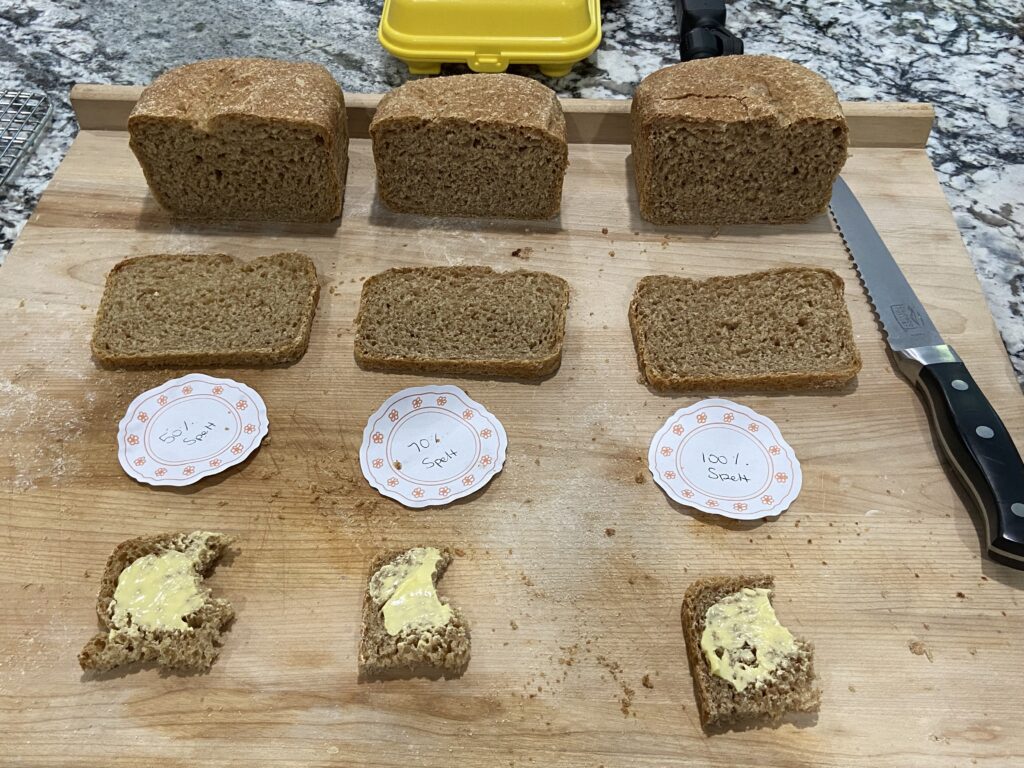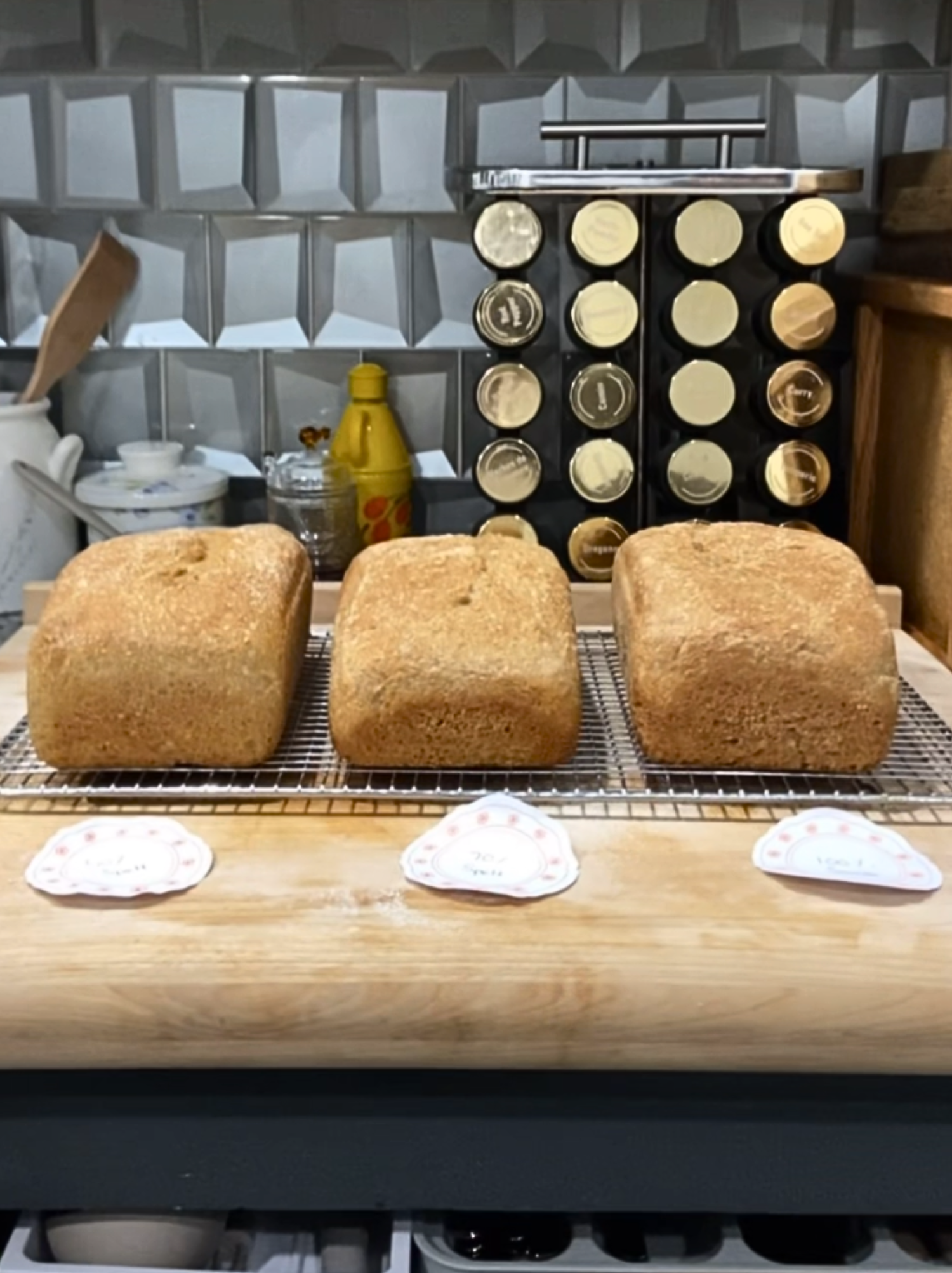My goal for Flourish Mill & Grain is to develop a recipe book with highly nutritious baked goods. I’m constantly experimenting with flour blends to find that sweet spot between nutrition and practicality. I’m trying to have ancient grains as the highlight in these recipes but also know that Hard White (with it’s high gluten structure) is easier to work with. So for my first question and experiment;
“Is Spelt better than modern wheat? And if so… how much can I use in my everyday sandwich bread?”
To find out, I ran a side-by-side baking test using three different flour ratios in sandwich loaves:
- 50% Spelt / 50% Hard White
- 70% Spelt / 30% Hard White
- 100% Spelt
All other variables stayed the same — exact same ingredients, hydration, kneading time, proofing schedule, shaping, and bake time. The only thing that changed: the ratio of Spelt to Hard White flour.
What We’re Testing
Spelt is an ancient grain known for its higher nutrient content, deeper flavor, and easier digestibility compared to modern wheats. But it’s also notorious for having a weaker gluten structure, which can make it harder to work with — especially for soft, sandwich-style loaves.
So the question we set out to answer was:
How far can we push the spelt ratio before the loaf becomes too fragile to be functional?
We observed:
- How easily the dough doubled in bulk
- How easy or difficult it was to shape
- How each loaf performed during baking
- And finally, we evaluated the appearance, crumb, structure, flavor, and nutrients

Rise & Shaping Notes
- 50% Spelt: Rose predictably. The dough was strong and elastic, easy to shape into a smooth loaf.
- 70% Spelt: Slightly more fragile and stickier, but still manageable. Rose well, though a bit flatter in the oven (I’m thinking maybe it’s because it was in the center of the oven).
- 100% Spelt: Very soft, borderline fragile, the crust cracked a bit. Shaping was the hardest as it was super sticky.
Appearance
- 50% Spelt had the best overall dome and oven spring. Classic sandwich loaf look.
- 70% Spelt was flatter, possibly due to a weaker gluten network combined with a hot spot in the center of the oven.
- 100% Spelt baked up beautifully rustic, overall was my favorite in look.

Crumb Texture
- 50% Spelt had a tight, even crumb. Slightly more chew and structure — perfect for sandwiches.
- 70% Spelt had a soft, very even crumb with a little more moisture and sweetness.
- 100% Spelt had a looser, more open crumb that bordered on crumbly in some spots.
Structure & Sliceability
- 50% Spelt was the easiest to slice cleanly. No tearing or squishing.
- 70% Spelt still held together well but required a gentle hand.
- 100% Spelt was noticeably more fragile and crumbly — slices didn’t hold up as well for sandwiches.
Flavor
- 50% Spelt had a mild, familiar flavor. Slightly nutty and sweet.
- 70% Spelt was rich and balanced — deeper flavor while still soft and versatile.
- 100% Spelt had the most flavor complexity. Nutty, earthy, and naturally sweet — best for toast or buttered slices.
Nutrient Profile
Ancient grains tend to have more nutrients per loaf than modern grains like Hard White. While Hard White makes it easier to work with the goal of this research was to see if the nutrients lost using just hard white matters. Here’s how the nutrients compare per slice (based on 70g of flour), comparing 100% Hard White loaf with 50% Hard White + Spelt Combo:
| Nutrient | How Spelt Compares | Why It Matters |
|---|
| Protein | Slightly higher + better amino acid balance | Builds and repairs tissues; supports muscle and immune health |
| Fiber | ~34% more than modern wheat | Supports digestion, gut health, and blood sugar regulation |
| Magnesium | ~33% more | Crucial for nerve function, sleep, stress response, and energy production |
| Manganese | Over 2x more | Supports metabolism, blood sugar balance, and antioxidant defenses |
| Zinc | ~33% more | Boosts immune function, skin repair, and cell growth |
| Copper | ~66% more | Supports red blood cell formation and iron absorption |
| Phosphorus | ~22% more | Essential for strong bones and energy metabolism |
| Iron | Slightly higher | Prevents fatigue; carries oxygen through the blood |
| Thiamin (B1) | Slightly higher | Helps convert food into energy; supports brain and heart |
| Niacin (B3) | Higher | Supports energy, skin health, and nervous system function |
So even at just 50% spelt, you’re getting a clear bump in fiber, magnesium, and trace minerals — without sacrificing structure.
Conclusion: My Winner — 50% Spelt
While the 70% loaf had a lovely flavor, and the 100% spelt loaf felt like a rustic, nutrient-dense treat, the 50/50 blend won for overall usability.
It was:
- The easiest to shape
- The most consistent in baking
- The strongest for slicing & held up in a sandwich
- And still significantly more nutritious than 100% Hard White bread
This makes it the best choice for everyday sandwich loaves, especially if you’re milling at home and want to ease into ancient grains without stress.
